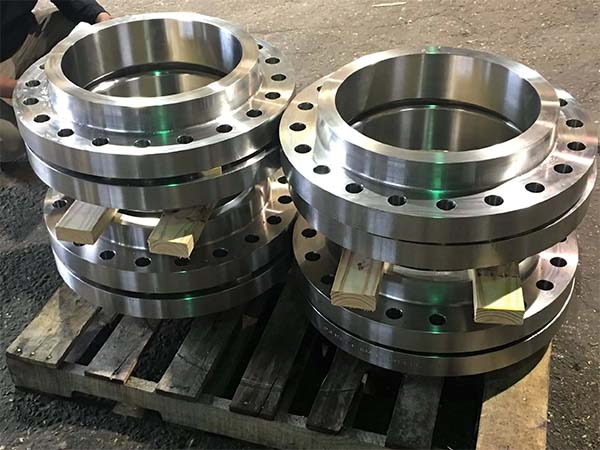A
flange is a connecting component used to connect pipes, valves and other equipment in a pipeline system. It can establish a firm connection and prevent leakage of pipes or valves and other equipment. They are easy to assemble, disassemble and maintain, and the standards for flanges are very rich, mainly classified by region and application field. The following are common flange standards:
ASME/ANSI American standard system
ASME B16.5: applicable to ½ "to 24" carbon steel, stainless steel and other pipe flanges, covering pressure ratings 150-2500 Class, standardized dimensions, pressure-temperature ratings, sealing surface forms, etc.
ASME B16.47: for large flanges >24 ".
ASTM material standards: such as ASTM A182 (stainless steel/alloy steel), ASTM A105 (carbon steel), A350 (low-temperature carbon steel), etc.

European standard/DIN/ISO/EN
DIN: German standard, compatible with ISO 7005 and EN 1092, using metric dimensions and PN pressure rating.
EN 1092-1/2/3/4: standard for steel, iron, alloy and aluminum alloy flanges, replacing the old DIN 2501/BS4504 system.
British Standard/BS
BS 10: old British nominal size standard;
BS 4504: later adopted DIN, later replaced by EN 1092.
JIS (Japan)
Standards such as JIS B2220 (steel pipe flanges), B2291 (hydraulic system flanges).
AWWA (Water Conservancy)
Designed for drinking water and water treatment systems, such as AWWA C207/C228 flanges.
Chinese standard System
GB/T 9112-9124 (2010 Edition) : Steel pipe flanges, including PN series (European system) and Class series (American system), detail the types and structures of flanges.
Industry standards: HG (chemical industry), JB (mechanical industry), SH (petrochemical industry), and Marine standards, etc.
In addition to different standards, flanges also vary in type. According to the connection method, flanges can be classified into flat welding, necked butt welding, necked flat welding, ring connection (loose sleeve), socket welding, threaded (PT), blind plate flanges, etc. Common sealing surface forms include flat surface (FF), convex surface (RF), annular groove (TG), and annular connection (RJ).
In addition to types, the commonly used materials for flanges are also very diverse. The selection mainly depends on the operating conditions (such as pressure, temperature, and corrosiveness of the medium). The more common materials include:
Carbon steel material: Carbon steel is one of the most common and cost-effective materials, suitable for general environments and medium and low-temperature working conditions. Common grades include ASTM A105, ASTM A350 LF2/LF3, ASTM A694 F42/F60, etc.
Stainless steel material: Stainless steel is a material with excellent corrosion resistance. Flanges made of stainless steel also have strong corrosion resistance and are often used in food, pharmaceutical, seawater and chemical industries. Common grades include ASTM A182 F304/F304L, ASTM A182 F316/F316L, as well as grades such as 321, 347, and CF8C.
Alloy steel material: Alloy steel contains elements such as chromium and molybdenum, which can significantly enhance the strength of the material and is suitable for high-temperature and high-pressure environments. Common grades include ASTM A182 F5, F9, F11, F22, and F91, which are widely used in the oil refining and power generation industries.
Duplex and superalloy materials: Duplex stainless steel features high strength and resistance to stress corrosion, especially to chlorides. Nickel-based alloys feature high strength and corrosion resistance, and are widely used in high-end chemical, Marine and nuclear industries.
Why do customers choose CENTRAL STEEL?
As a leading manufacturer of pipes and fittings in China, CENTRAL STEEL is committed to providing high-performance and highly reliable flange products to customers worldwide. Our advantages are reflected in:
1. Carefully select high-quality materials
It adopts top-grade carbon steel, alloy steel and stainless steel raw materials both at home and abroad. All materials comply with multiple international and domestic standards such as ASTM, GB and EN.
The chemical composition and mechanical properties of the materials have been tested by a third-party authoritative authority to ensure the pressure resistance, corrosion resistance and high-temperature resistance of each flange.
2. Precision forging and processing technology
The core equipment includes high-pressure forging machines, CNC lathes, fully automatic plasma cutting and CNC machining centers. The flatness and concentricity accuracy of flanges can reach within ±0.1 mm.
The proprietary heat treatment and tempering process significantly enhances the uniformity of the flange's structure and its crack resistance.
3. Complete specifications, full coverage of all product categories
Supports ANSI/ASME B16.5, B16.47; DIN/EN 1092; GB/T 9112-9124; The full range of standards such as JIS B2220.
From ½ "to 60", 150 - 2500 Class, all kinds of flat welding, necked butt welding, socket welding, blind plate, ring connection and other types are available.
4. International quality certification
Certified by ISO 9001, PED, CE, API 6A/6D and other systems, the products are sold to more than 30 countries and regions in Europe, America, the Middle East, southeast Asia, etc.
Each batch leaving the factory is equipped with a complete material certificate (MTC), inspection report and factory test record.
